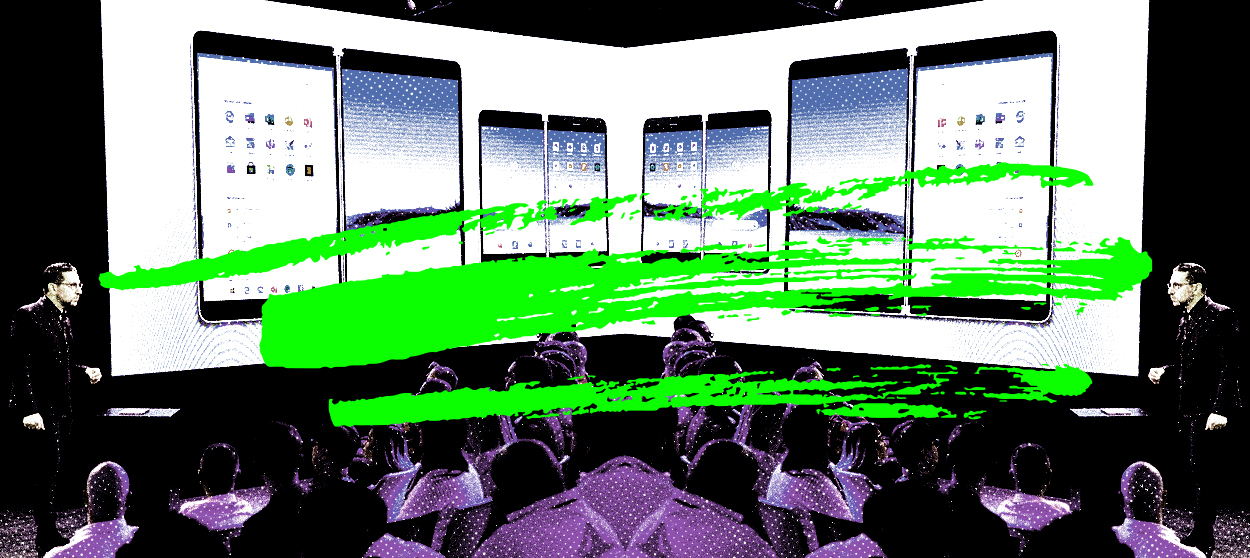Is Microsoft's Surface Neo too little too late?
Why the most exciting tech products in years might not be enough to make a dent in the market


Tech events are rarely surprising these days. And for most of Microsoft's hardware event this week, it seemed like it too would be more of the same.
But toward the end of the event on Wednesday, Microsoft did something truly surprising: first by announcing a new dual-screen tablet device called the Surface Neo; and then by announcing a smaller version called the Surface Duo that is also a phone, which happens to run Google's Android. For the first time in a while, I was genuinely caught off guard by a tech announcement.
In part, it was because the rest of the event's content had been leaked. But it was also because, with the Surface Neo and Duo, Microsoft presented what are perhaps the most interesting tech products in years.
The Week
Escape your echo chamber. Get the facts behind the news, plus analysis from multiple perspectives.

Sign up for The Week's Free Newsletters
From our morning news briefing to a weekly Good News Newsletter, get the best of The Week delivered directly to your inbox.
From our morning news briefing to a weekly Good News Newsletter, get the best of The Week delivered directly to your inbox.
Yet having put their best foot forward, Microsoft is still facing a serious challenge: its best may not be enough. As genuinely surprising and impressive as the new Surface products are, they may paradoxically still be too little, too late.
The meat and potatoes of the event was the upgrade to Microsoft's existing products. Their flagship Surface Pro line was updated with new processors and finally has USB-C. Meanwhile, the standard clamshell Surface Laptop got the same, while also giving consumers the option to upgrade to an aluminium covering on the keyboard rather than the controversial fabric on the previous model. It also got a new, larger 15" model. They were solid if incremental releases, and it's easy to recommend these new products to anyone looking for a new, high-end laptop.
More interesting, however, was the Surface Pro X, a new 2-in-1 device akin to the Surface Pro, but which uses ARM chips, which are the sort used in smartphones and tablets. The upside here is that the Pro X is very thin and light, and promises 13 hours of battery life. The downside is that Microsoft hasn't yet figured out how to get important pieces of software like Adobe Photoshop running on the new chips. Performance has also been an issue with Windows on ARM thus far, so until review units ship out, it's impossible to know how promising this new device is.
But it was the promise of something better that really drove this Microsoft event. First, a long-rumored dual-screen device was finally shown off. Called the Surface Neo and releasing at the end of 2020, it looks genuinely impressive.
A free daily email with the biggest news stories of the day – and the best features from TheWeek.com
It is in essence two 9-inch screens joined with a hinge, and with a new Windows X operating system meant to take advantage of the new form. So, for example, in the Mail app, one's inbox will be on the left side, with individual emails or a calendar on the right. Similarly, links from one app will open in a new browser on the other screen. Flipped horizontally, the device can work like a small laptop, and even allows for a hardware keyboard to be placed over part of the bottom screen for easy typing. There is also a space called the Wonderbar which is a larger version of Apple's Touch Bar for adding things like emojis or gifs as you type.
The whole concept echoes Microsoft's famous Courier experiment from a decade ago, which promised to be a digital notebook. And it is just that which is most intriguing about the Surface Neo: it's like a digital journal with a pen for handwritten notes, that can also act like a laptop when one needs it. In short, it's an ideal work on the go device.
The trouble, though, is that while the device may well be appealing to creatives, journalists, and those who are very mobile — I mean, I certainly want one — it is also quite niche. Though Microsoft's Surface line has always been about creating new categories, as it did with the 2-in-1, it's hard to see a device this focused gaining a foothold against the army of laptops, tablets, and smartphones that already do most of what the Neo can — if perhaps less elegantly.
That too is the problem for the Surface Duo, the smaller version of the Neo that is also a phone and, shockingly, runs Android. It too promises the same versatility as its larger cousin, as the two screens do allow for similar variety and more room to work. It again seems very futuristic and intriguing. But it faces an uphill battle in terms of adoption, both from users who may be wary of a niche, inevitably expensive device, but also developers, who may be hesitant to develop apps for this marginal product instead of the billions of already existing smartphones and tablets.
And that ultimately is the challenge facing Microsoft. The dual-screen model feels legitimately novel, and it's easy to see how it might be beneficial to people looking to work on the go. But it's hard not to think that the Surface Neo might be like the Surface Pro in its effect.
The Pro is a solid success, and inspired other companies, including Apple, to create hybrid devices. But it also never set the world on fire, and it is absolutely dwarfed in sales by the iPad Pro. Ultimately, it is an excellent product that only staved off the irrelevance of Windows for just a bit longer. And despite being the most interesting tech products in years, I fear the new Surface devices may suffer just the same fate: to be innovative, interesting, and simply too late to make a difference.
Want more essential commentary and analysis like this delivered straight to your inbox? Sign up for The Week's "Today's best articles" newsletter here.
Navneet Alang is a technology and culture writer based out of Toronto. His work has appeared in The Atlantic, New Republic, Globe and Mail, and Hazlitt.
-
 Political cartoons for January 17
Political cartoons for January 17Cartoons Saturday’s political cartoons include hard hats, compliance, and more
-
 Ultimate pasta alla Norma
Ultimate pasta alla NormaThe Week Recommends White miso and eggplant enrich the flavour of this classic pasta dish
-
 Death in Minneapolis: a shooting dividing the US
Death in Minneapolis: a shooting dividing the USIn the Spotlight Federal response to Renee Good’s shooting suggest priority is ‘vilifying Trump’s perceived enemies rather than informing the public’
